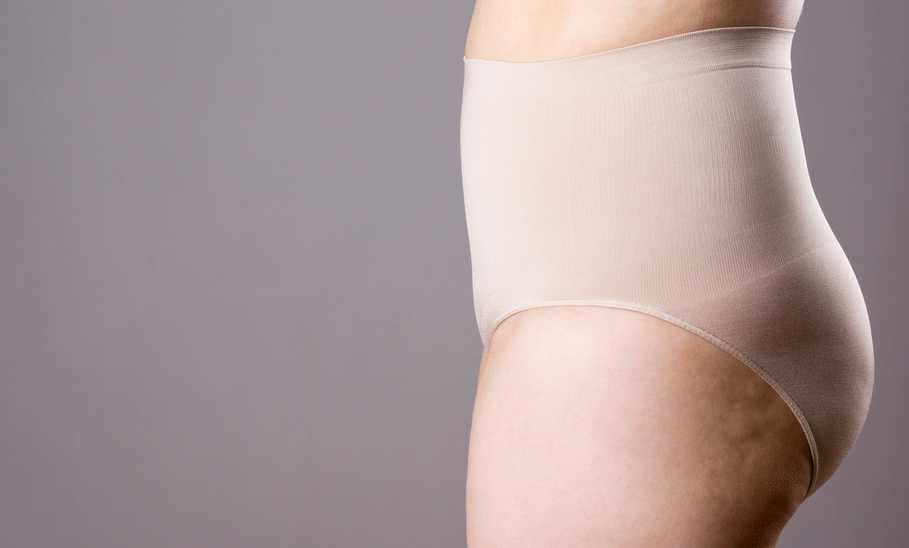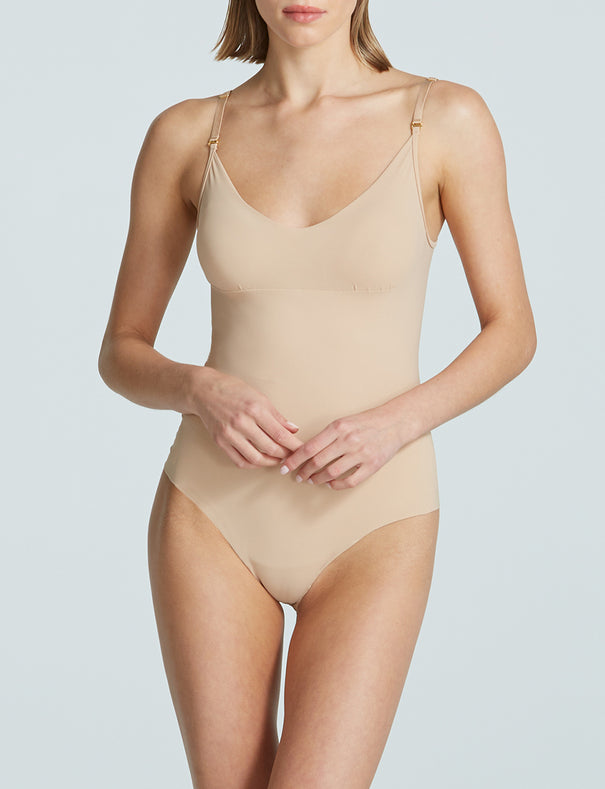What Does Shapewear Do? The Ultimate Guide to Shaping Undergarments

Our evaluations and opinions are not influenced by our advertising relationships, but we may earn a commission from our partners’ links. This content is created by TIME Stamped, under TIME’s direction and produced in accordance with TIME’s editorial guidelines and overseen by TIME’s editorial staff. Learn more about it.
ƒPeople have been sculpting their body appearance with various kinds of shapewear for centuries. Some of the first iterations were in the form of corsets made from thick fabric and fitted with steel or whale bones. They were quite constrictive and likely not very comfortable. Our current shapewear has a decidedly gentler feel, though it’s still capable of compressing and contouring our bodies.
“Shapewear works by using a combination of compression, support, and contouring to smooth, sculpt and enhance the body's natural curves, providing a sleeker silhouette under clothing,” explains Cami Raymond, Senior Design Director of Ruby Ribbon the women's shapewear, intimates, and athleisure company. “Shapewear can be a fantastic tool to enhance your confidence and silhouette,” adds Kadeem Alphanso Fyffe, Fashion Designer, Consultant and Author of Threading the Needle. “It has gained popularity for men and women in recent years.”
“Shapewear should be viewed as an accessory that empowers your style and boosts your confidence,” says Jane Newman, Chief Design Officer, Global Innerwear, HanesBrands.“The right silhouette enhances, not hides, your shape.” Maidenform (Hanes’ shapewear line) focuses on helping consumers feel supported while embracing their individual shape and looking incredible while still feeling comfortable.
Shapewear is available in a wide range of styles. Some target a specific body area such as tummy control shapewear, while others are designed for a particular kind of garment or event such as bridal and wedding shapewear. It's available for all sizes of people, including shapewear for plus size.
“Shapewear garments are designed to compress certain areas of the body, such as the abdomen, waist, thighs or buttocks,” says Raymond. The compression helps smooth out bulges and create a more streamlined appearance.
To achieve their compressive and contouring capabilities, shapewear is made from materials with varying levels of elasticity, as well as strategically placed panels and seams that create the compressive and contouring effects.
“These details can lift and sculpt certain areas while also providing a slimming effect,” explains Raymond.
While shapewear offers compression and support, it's essential that it remains comfortable to wear for extended periods. This is why Ruby Ribbon’s shapewear “incorporates breathable and lightweight materials that ensure comfort while still delivering excellent shaping,” says Raymond.
Using compression technology and fabrics, shapewear offers a smoothing and sculpting effect to the wearer while on the body, offering a more streamlined silhouette and possibly making you feel more comfortable and confident.
That said, these garments do not provide any lasting effect – meaning after you take off the shapewear, everything settles back into its natural place. It does not help you burn fat or “sweat away” inches from a specific area.
As a tailor and pattern maker, I know that constructing shapewear with seams (cut and sewn as opposed to knitted like tights or hosiery) allows designers to pinpoint specific areas with curved seams that contour, shape and, when desired, enhance these areas. Seamless knitting, on the other hand, usually simply flattens out the curves and bumps.
Both of these techniques work to slim the body, just in different ways.
By slimming and contouring specific areas of the body, shapewear helps create a smoother silhouette and reduces the appearance of bulges, like this sleek bodysuit from Commando. Ultimately, says Raymond, “it can create a more streamlined look under clothing which enhances your overall appearance.”

“Some shapewear provides support to the back and core muscles, which can help improve posture and reduce discomfort from prolonged sitting or standing,” explains Raymond. This can give you a more confident and poised appearance.
“Shapewear can help the fit of form-fitting or body-conscious clothing,” Raymond says. It eliminates panty lines and smooths out bulges. As a tailor and pattern maker for film, television and fashion, I’ve fit all kinds of body-hugging clothing on a variety of actresses and performers and, nine times out of ten, we end up using some sort of shapewear underneath. It just makes the overall look more stunning. Many of the people I’ve worked with say it makes them feel more confident and secure.
Speaking of confidence, Raymond says that’s one of the key benefits of shapewear. “Knowing that you have a smooth and streamlined silhouette under your clothing can boost confidence and make you feel more at ease throughout the day,” she says.
Another great benefit of shapewear is that it helps prevent muscle fatigue, as well as reducing strain on certain areas of your body (as mentioned above). Shapewear garments made to support the back or bust, for instance, can add support to help prevent back pain by improving your posture. I personally wear cycling tights with a medium compression because they help keep my muscles from becoming fatigued during long (60 to 90 mile) bike rides.
To be both comfortable and effective, make sure you pick the correct size. Raymond suggests referring to the sizing chart provided by the manufacturer and taking accurate measurements of your bust, band, waist, hips, and other relevant areas. This will help you be sure to select the size that will be best for you. She cautions against sizing down too much, as this can “lead to discomfort and distortion of the garment.”
“Step into your shapewear and pull it up slowly, making sure it sits evenly and comfortably on your body,” says Raymond. As anyone who has pulled on a pair of highly-compressive Spanx knows, this process may involve some pulling, tugging, adjusting and smoothing to get rid of any wrinkles or bulges, not to mention a bit of patience. Also, avoid rolling or folding the edges of the shapewear, as this can create lines or bumps under your clothing; the exact opposite of what you’re trying to achieve.
Think about the type of clothing you'll be wearing over your shapewear. For example, explains Raymond, “if you're wearing a form-fitting dress, opt for shapewear that smooths and contours the entire torso.” For pants or a skirt, choose something that focuses on the waist and hips.
Since there are many styles and levels of control available, Newman suggests giving yourself some time to try on a few styles and levels of support, so you find your perfect shapewear. “Think through what type of support and control you are looking for as well as the comfort level you desire,” she says. This will make it easier to sift through all the available styles to find those that will potentially suit your needs.
Honestly, whenever you want. Some people wear it every day, while others only wear it for special or formal events. The trick is to find a piece (or pieces) that are supportive for your fashion needs as well as comfortable for ease of wear.
“Wearing shapewear daily is a personal choice,” says Raymond, “but it's essential to consider both the benefits and potential drawbacks before making it a regular part of your wardrobe.” Many shapewear pieces are designed to be worn every day if you so desire. Newman says, “there is absolutely nothing wrong with wearing shapewear every day, as long as you feel comfortable.” Comfortable being the operative word. Ultimately, you should do what feels right to you.
This number depends on several factors, says Raymond, including “the specific garment, its compression level, your body type and how well it fits you.” The higher the compression level, the more potential there is for shaping and slimming effects, she explains. However, these levels may also feel more restrictive and uncomfortable. Shapewear typically targets specific areas of the body, such as the abdomen, waist, hips, thighs, or buttocks. “The number of inches it can "take off" may vary depending on which areas you're looking to shape or smooth,” explains Raymond.
Generally, shapewear can compress an inch or two off your body. Remember, though, that a proper fit is crucial for shapewear to be effective (all the experts I talked to stressed this). If the garment is too tight or too loose, it may not provide the desired shaping effects, as well as possibly being uncomfortable to wear. Be sure to follow sizing guidelines provided by the manufacturer and choose shapewear that fits your body comfortably.
The information presented here is created by TIME Stamped and overseen by TIME editorial staff. To learn more, see our About Us page.



